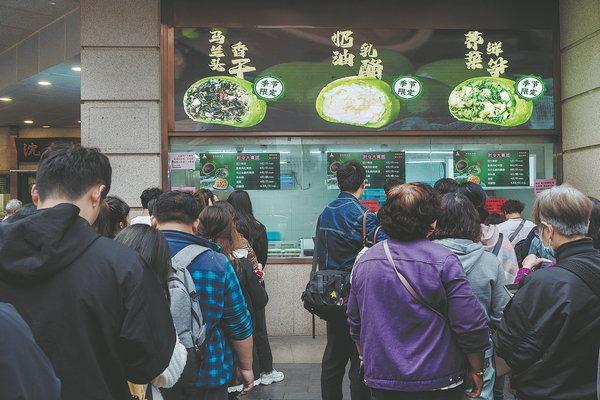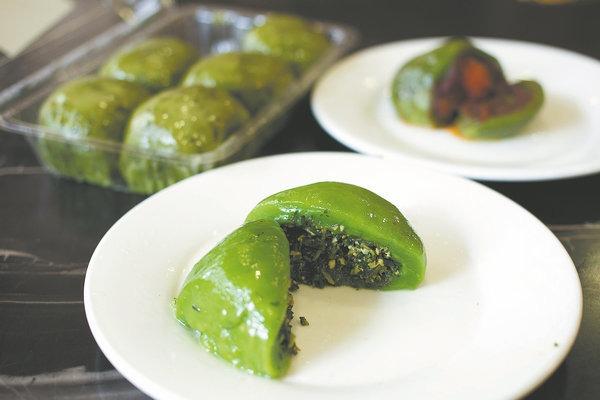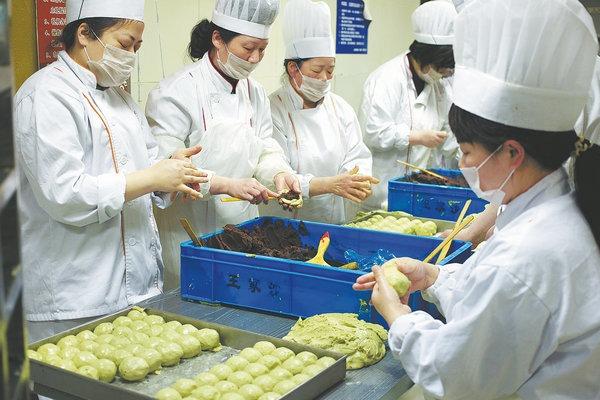Traditional Qingming Festival snack gets makeover with novel stuffings, earning it appreciation beyond the Jiangnan region, Lin Shujuan reports.
 Customers line up to purchase qingtuan at Shendacheng, one of the century-old delicacy brands in Shanghai that is keen on innovating new varieties of the spring snack. (GAO ERQIANG / CHINA DAILY)
Customers line up to purchase qingtuan at Shendacheng, one of the century-old delicacy brands in Shanghai that is keen on innovating new varieties of the spring snack. (GAO ERQIANG / CHINA DAILY)
Every year, from mid-March to early April, as the Qingming Festival approaches, Zhang Min's life revolves around the green glutinous rice balls known as qingtuan.
A native of Shanghai in her early 50s, Zhang previously ran a restaurant for over a decade. Thanks to her culinary expertise, she has garnered a loyal following on WeChat for her homemade seasonal delicacies, with qingtuan being one of her most sought-after treats.
The delicacy's shiny green exterior is made of glutinous rice flour mixed with freshly extracted green grass juice, and emits a delightful aroma. Typically, it contains stuffing like sweet red bean paste. First made about 1,000 years ago, qingtuan originated as a sacrificial offering and has evolved into a seasonal street snack popular in southern China during the annual Qingming Festival.
In recent years, driven by endorsements from key influencers on social media and the publicity generated by the new fillings introduced every year by established Shanghai food brands, the appeal of this seasonal delicacy has transcended its traditional production area in the Jiangnan, or the region south of the Yangtze River along its lower reaches, to get to nearly every corner of the country.
 Qingtuan stuffed with minced Indian aster and dried bean curd is one of the most popular specialties Wangjiasha has to offer. (PROVIDED TO CHINA DAILY)
Qingtuan stuffed with minced Indian aster and dried bean curd is one of the most popular specialties Wangjiasha has to offer. (PROVIDED TO CHINA DAILY)
This surge in popularity is evident not only in the long queues forming outside Shanghai's venerable stores but also in the hundreds of thousands of orders placed on e-commerce platforms like Taobao and JD, as well as on fresh grocery delivery apps like Dingdong.
For Zhang, the growing popularity of qingtuan means an influx of orders from her friends and relatives in the three weeks leading up to Qingming, which falls on Thursday. Nevertheless, she embraces the busiest season of the year and celebrates the resurgence of qingtuan, which she says embodies the magic of Chinese culinary tradition.
Many traditional delicacies, like tangyuan (glutinous rice balls stuffed with black sesame or peanut butter) for the Lantern Festival and zongzi (sweet or savory stuffed rice dumplings wrapped in bamboo leaves) for the Dragon Boat Festival, use glutinous rice as a primary ingredient. What sets qingtuan apart is its use of the green juice extracted from tender grass, which is only available in spring. This makes it a seasonal delicacy. With its soft, sweet texture and fragrant grassy aroma, it symbolizes the end of winter and the arrival of warmer weather.
 Staff members at Wangjiasha, a delicacy store with more than 60 years of history in Shanghai, prepare qingtuan right on the spot at the store. (PROVIDED TO CHINA DAILY)
Staff members at Wangjiasha, a delicacy store with more than 60 years of history in Shanghai, prepare qingtuan right on the spot at the store. (PROVIDED TO CHINA DAILY)
While qingtuan has long been cherished as a taste of spring by the people of the Jiangnan region, in 2016, Xinghualou, a century-old Shanghai brand, introduced a novel filling — salted egg yolk and pork floss — which was quickly championed by key social media influencers.
Each year, established Shanghai names, including Shendacheng, Wangjiasha, and especially Xinya, introduce new varieties, attracting novelty-seeking customers
Since then, the delicacy has broken free of its status as a regional snack, and has become a must-buy for foodies around the country every Qingming. Despite initial doubts about its sustained popularity, it has proved to be an exception. New fillings have been introduced every year, and this creativity has prompted a reconsideration of the magic of this traditional yet seemingly mundane snack.
Each year, established Shanghai names, including Shendacheng, Wangjiasha, and especially Xinya, introduce new varieties, attracting novelty-seeking customers. The range of fillings has expanded from the traditional sweet red bean paste to include salted egg yolk with shredded pork, hairtail fish, dried bean curd with Indian aster, pickled freshwater fish, hairy crab roe, and even beef curry.
Xinya has been at the forefront of the most innovative offerings, with its new varieties often being the most unexpected. This year, it has incorporated hairtail fish and Chinese toon, both seasonal ingredients, into its list of fillings. According to Chen Jie, the store manager at the Xinya branch on Nanjing East Road, it has proved particularly popular.
Currently, the daily sales at the store range from 7,000 to 8,000, peaking at close to 20,000 during busy times, Chen says.
A similar level of popularity can be seen at the Changli branch of Dexingguan, a time-honored brand that dates back over 100 years, which primarily serves qingtuan with traditional flavors.
 A tourist takes a photo of qingtuan bought at Shendacheng with the storefront as a background. (GAO ERQIANG / CHINA DAILY)
A tourist takes a photo of qingtuan bought at Shendacheng with the storefront as a background. (GAO ERQIANG / CHINA DAILY)
Zhang Jian, the inheritor of intangible cultural heritage at Dexingguan, emphasized that their qingtuan are made and sold on the spot, following traditional methods and using pure natural barley grass juice, which imparts a fresh aroma and retains the traditional taste. The sales of qingtuan currently range from 3,000 to 5,000 a day, with an estimated peak of around 10,000 during Qingming.
"The traditional method of making green rice balls allows residents to taste the spring in a timely manner," Zhang Jian says.
One resident, also surnamed Zhang, who has been a regular customer for years, agrees. He says purchasing qingtuan at Dexingguan has become a family tradition to welcome the arrival of spring.
It is generally believed that the essence of Chinese cuisine is to consume the right food in the right season. Qingtuan is the very embodiment of that essence.
Zhang Min, Shanghai resident
Qingtuan also appeals to the younger generation. One tourist recently purchased eight at Dexingguan, saying that her daughter, who previously studied in Shanghai, had been feeling nostalgic for freshly made qingtuan from the old brand stores.
While many attribute the rise of new flavors and the enduring appeal of old sentiments to the longstanding popularity of the delicacy, Zhang Min slightly disagrees.
Though she is a Shanghai native, Zhang Min disliked the delicacy until 2018, when she participated in a small qingtuan workshop where her interest was piqued. It was then that she realized that it was a tradition, rather than a cheap snack.
"Once you understand the culture and tradition qingtuan embodies, you'll appreciate it as a seasonal delight," Zhang Min says. "It is generally believed that the essence of Chinese cuisine is to consume the right food in the right season. Qingtuan is the very embodiment of that essence."
Since then, she has become an enthusiastic maker of the delicacy and has devised a number of new fillings. Following numerous trials, she introduced new varieties featuring fillings such as jujube paste and pine nut, that have earned her a constant following.
Zhang Min is careful to use only high quality ingredients and takes a precise, caring approach to making the qingtuan.
"In qingtuan, I see the respect our ancestors had for food and nature, which is its enduring appeal for me," she says.
Liu Kexin contributed to this story.


